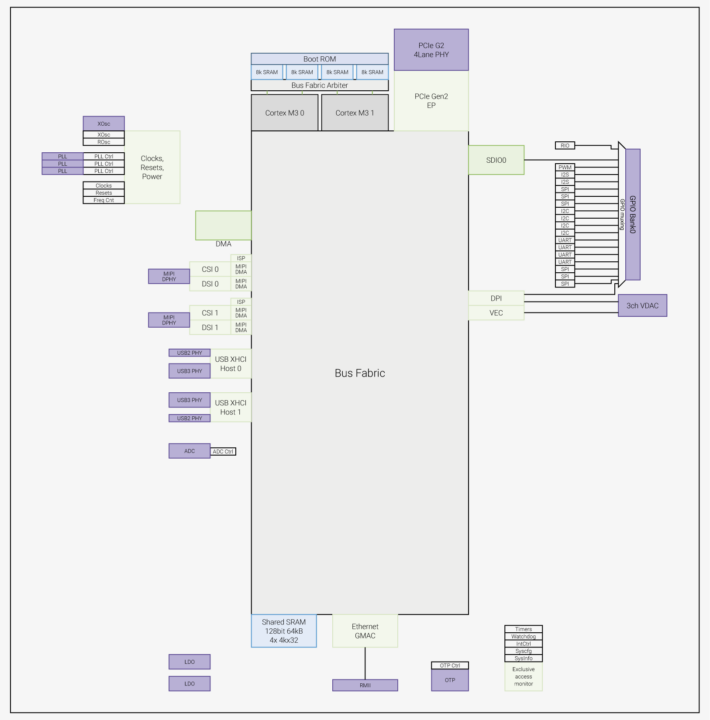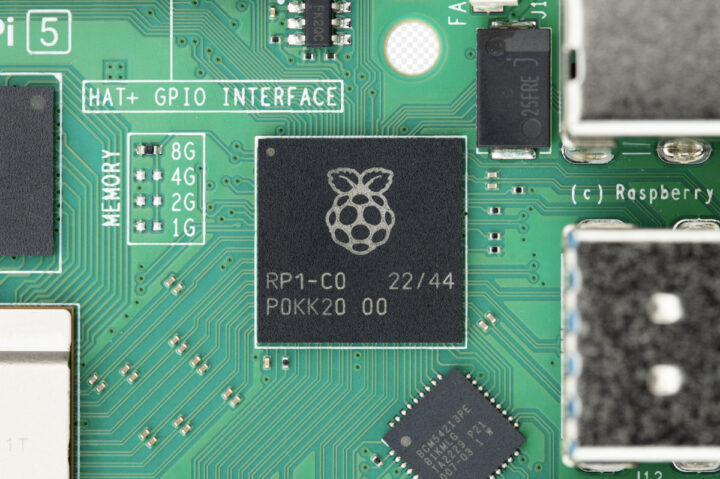The Raspberry Pi 5 was recently introduced with the Broadcom BCM2712 CPU and the RP1 chip handling I/Os designed in-house by the Raspberry Pi just like they did for the RP2 (RP2040) microcontroller, and we now have more details about the Raspberry Pi RP1 including a (draft) datasheet and a block diagram.
The RP2040 came out before the RP1 peripheral controller as the design for the latter started 7 years ago with a total R&D budget to develop the Raspberry Pi 5 of around 25 million dollars. While at launch, we knew the RP1 handled some peripherals, doubled USB bandwidth with two separate USB 3.0 hosts, and embedded higher speed MIPI interfaces, it was unclear whether some of the other connections came from the BCM2712 or RP1 chips. But we now do know with the release of the datasheet.
Raspberry Pi RP1 key features and specifications:
- MCU – Dual-arm Cortex-M3 microcontroller with 64KB SRAM, TCM, bootROM for platform configuration and management
- Host interface – PCIe 2.0 x4 bus
- MIPI camera/display interfaces
- 2x MIPI CSI-2 camera controllers and 2x MIPI DSI display controllers connected to 2x shared 4-lane MIPI DPHY transceiver PHYs for up to 8 Gbps bandwidth.
- Each camera controller incorporates an image signal processor front-end (ISP-FE) which pre-processes incoming image data.
- Possible configuration include 2x cameras, 2x displays, or a one display + one camera
- Networking – Gigabit Ethernet MAC (RGMII)
- USB – 2x XHCI controllers each connected to a single USB 3.0 PHY and a single USB 2.0 PHY for up to 10 Gbps total bandwidth (5Gbps per XHCI controller)
- GPIOs
- 28x GPIO pins
- 5V tolerant, and 3.3V-failsafe (supports a voltage of up to 3.63V applied when RP1 is unpowered)
- GPIO alternate functions
- Storage – eMMC/SDIO bus with a 4-bit interface
- Display – 24-bit DPI output
- Audio – 2x I2S, stereo PWM audio output (AUDIO_OUT)
- 5x UART, 6x SPI, 4x I2C
- 4-channel PWM output
- Interrupt generation from pin level or edge transitions
- Clocks
- 1x Clock Producer instance
- 1x Clock Consumer instance
- General-purpose clock input and output (GPCLK)
- RIO – Registered IO interface to allow the host processor to manipulate GPIOs
- Misc
- 8-channel DMA Controller (DMAC) for servicing low-speed peripherals.
- 3x integrated PLLs consisting of 2 fractional-N PLLs to support the generation of independent video and
audio clocks, and 1x integer PLL to generate system clocks. - A five-input successive-approximation analog-to-digital (ADC) converter with 12-bit resolution at 500kSPS with
9.5 ENOB (Effective number of bits), 4 external inputs, one internal temperature sensor
- Dimension – 20mm² die
- Process – TSMC’s 40LP (Note: the BCM2712 is manufactured with a 16nm process)

There’s no mention of flash storage for the firmware, but Eben Upton explains the datasheet release is only partial and aimed at developers implementing drivers for the Raspberry Pi 5 SBC. It also looks like the Raspberry Pi RP1 may have some hidden (i.e. yet-to-be-publicly-documented) features as we’re told “while we are looking at exposing more of the features of RP1, both in software and with further documentation, that’s going to be something you might see a little later on”.

Jean-Luc started CNX Software in 2010 as a part-time endeavor, before quitting his job as a software engineering manager, and starting to write daily news, and reviews full time later in 2011.
Support CNX Software! Donate via cryptocurrencies, become a Patron on Patreon, or purchase goods on Amazon or Aliexpress





